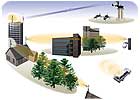
For line-of-sight installations, 5.8 GH is recommended for wireless transmission. The 900 MHz band uses a transmission pattern that is good for diffracting around obstacles.
Pulling wire is one of the most labor-intensive activities of a security system installation. With the growing use of access control systems in facilities, secure ways of avoiding that expense should be welcomed by security dealers, systems integrators and their customers.
Besides not having to pull wires, wireless access control systems can be advantageous for retrofitting in existing buildings where wiring installation might be difficult, such as concrete block or historic buildings, and for connecting to remote locations, such as guard houses or gates, and other buildings.
These advantages are becoming more attainable with each improvement in wireless technology. As wireless communication broadcast distances and encryption improve, the devices are finding wider acceptance in the security dealers’ and systems integrators’ arsenal of security solutions.
Manufacturers have reached different levels of realizing the vision of access readers that can communicate easily, securely and wirelessly to control panels or bypass them completely on their way to a building’s network.
Differing methods, standards and protocols are being used with various systems. Most manufacturers’ products use wireless communication standards like 802.11b, 802.11g, or cellular telephone lines to communicate.
One of the biggest trends in wireless access devices is the increasing acceptance of the devices themselves. Although many major security equipment manufacturers do not offer wireless access control devices, Keyscan Inc., Whitby, Ontario, Canada, is seeing a trend toward wireless and is considering offering wireless access control capability by the end of this year.
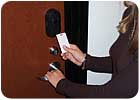
These wireless locks operate on batteries and can be installed in less than an hour, according to the manufacturer.
“There are devices out there already that secure wireless networks using the 802.11 protocol, which is encrypted right out of the gate,” Dentinger points out. “You can also layer in extra security on them as well. With the development of off-the-shelf OEM wireless products, it’s becoming a lot easier for companies to integrate a wireless solution into their offering.
“We’re anticipating as a new technology there will be some early adopters,” he asserts. “So we’re looking at it from the standpoint of, let’s start investigating now integrating it into our products for that main reason, not because the market right now is demanding it.”
Rick Rasmussen, vice president of sales and marketing for OSI Security Devices, Chula Vista, Calif., thinks the trend is moving slowly but inexorably to wireless systems.

Wireless access control at this airport in Renton, Wash., eliminated trenching or tunneling of wires across the runway.
“This isn’t to say that wireless systems do everything that a wired system does, because we don’t have video integration yet,” Rasmussen admits. “But they still do have the majority of the features and benefits of a hard-wired system.”
As wireless systems become more mainstream, Rasmussen expects integrators will get more comfortable with them.
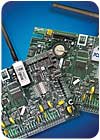
The self-forming and self-healing mesh network architecture used in these wireless access control systems, permits data and control messages to pass from one controller to other controllers via multiple paths. This extends the range of the network and improves data reliability.
Robert Bayer, director of sales and marketing for PCSC, Torrance, Calif., thinks the trend is moving inevitably toward wireless access control. “I think it’s just a matter of time before it’s in every product,” he maintains.
“It’s the convergence of the decision-making process of who manages security at the end-user level,” he explains. “There’s more involvement now from other departments. And because they have a sophisticated understanding of networks and communication, they know there are advanced solutions available that might not be the standard for security.

A conventional access control system requires extensive wiring. Wireless systems as add-ons or entire systems are designed to ease this effort.
Acceptance of wireless access control products is growing, Bayer thinks. “You’ve got a paradigm shift very similar to the burglar alarm industry,” he declares. “When they first introduced the wireless devices, people didn’t want to choose the lithium battery-operated motion detectors. It took a long time for people to see any value in that and to trust that method of communication.”
Equally positive about wireless technology is Lester LaPierre, marketing manager for Schlage Electronic Security, Ingersoll Rand Security Technologies, Carmel, Ind.
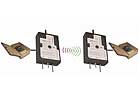
This series of wireless transceivers can transmit data between controllers at up to 500 feet.
LaPierre sees wireless now as more than just a niche market. “[Customers are] so comfortable, [integrators are] not doing it just as a niche, they’re doing it building-wide,” he declares. “Some customers have put wireless throughout a building.”
A hospital in Boston gutted a 12-story building and put radio frequency wireless access devices throughout it, he maintains. The University of New Hampshire has used wireless access control for 40 suite doors in a new residence hall and saved approximately $50,000 over a wired system, LaPierre asserts.
At press time, Mississippi State University expected to have more than 1,000 wireless access devices on campus by the end of last year, LaPierre reported.
He points out that installation time has been reduced to an average of 45 minutes for his company’s wireless access devices and that wireless access data can be more secure than wired because it is encrypted.
“More access control manufacturers are going to be embracing wireless as an integral part of their solution,” LaPierre insists. “I also think that end users are going to be expecting wireless as part, if not all, of the offering that is presented to them. It’s just a natural extension.”

For its gates, Santa Monica Municipal Airport uses TCP/IP networking via a wireless wide area network of control panels.
BROADBAND REPLACING WIRELESS
The increase in recent years in the penetration of broadband access has affected the use of wireless systems. Brivo Systems LLC, Bethesda, Md., started using cellular phone communications to connect its access control products wirelessly.“When we started in this business, all our products were wireless, so every installation was a wireless one,” notes Steve Van Till, president and COO, Brivo Systems LLC. That was in 2002, and many of those systems now are approaching five years in age.
“If you go back five years, broadband was not as ubiquitous as it is today, so many people chose to outfit with wireless gear,” he relates. “But now they no longer need wireless because they have broadband. Now there are multiple migration paths depending on individual circumstances.”
Using cellular telephone lines for communication can send information farther than other wireless methods, but using those lines is an additional expense. Brivo now sells 80 percent wired and 20 percent wireless systems.
“There’s not a business out there that doesn’t have DSL or a cable modem,” Van Till points out. “That created a real shift in terms of how many wired versus wireless system we sell.”
Dennis Geiszler, vice president of business development for Keri Systems Inc., San Jose, Calif., agrees. “Where we see the industry going is that there are so many systems now that are communicating on a common Ethernet or Internet platform, you now can deploy whatever method in an access control system. I see that as a growing trend,” he predicts.
“It’s just something on which the access control industry can piggyback,” Geiszler explains. “Systems like that aren’t widely deployed yet, but they are coming.”
A balancing factor for Dentinger is the wiring of buildings with Cat 5 cable that has occurred over the last few years.
“We’ve already significantly reduced the wiring cost, and in some cases reduced it to a very small amount labor-wise, because they already have network cable running through buildings,” he notes. “The wireless is taking it one step further. It’s a niche market for pre-existing buildings. If it’s not already Cat 5-enabled, it’s far more efficient to go with wireless.”
Use of wireless gear is helping to promote adoption of computer networks, believes Ray Shilling, vice president of sales and marketing at AvaLAN Wireless Systems Inc., Palo Alto, Calif.
“The wireless business is ironically helping the whole industry move to network-based technology, because it’s a reason to move to wireless,” he notes, adding that not having to trench, pull cable or scar parking lots is the advantage.
“So the wireless companies are best buddies of anybody coming in with an Ethernet or IP-based system, because they become much more competitive versus traditional analog systems,” Shilling maintains.
On the other hand, several biometric scanners connected wirelessly at each store of a major national retail drug chain suggest the opposite trend, thinks Shilling.
“You’ll see a kit, just a plug-and-play type system, and does that really help the biometric companies sell their product?” he asks. “The customer’s biggest objection is, ‘I don’t want to wire the whole facility.’ Now it’s just to provide the power wherever the biometric scanners are.”
Shilling adds that the drug store chain for which his company is providing wireless devices is not wiring its facilities for computer networks, which strengthens the argument for using wireless access control devices.
“If we look ahead three to five years, many of the devices that are analog now will be digital and hung off the network,” he predicts. “From our standpoint, that’s an opportunity for us. If they’re not wiring these stores and if that is typical in the industry, then they’re going to need a lot of wireless gear.”
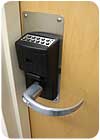
Suitable for retrofit applications, this wireless access reader with prox (HID 125KHz) is retrofit on a wood door. The backing plate covers holes left by a previously installed lock.
WHITHER WIRELESS?
Two schools of thought exist regarding wireless connection of access control systems, thinks Geiszler. One is to connect the readers to the controllers or control panel wirelessly, and the other is to connect the control panels wirelessly, but leave the readers wired.Deciding which portion of the access system to make wireless is not a problem for OSI Security Devices – their entire system is not only wireless but also does not need controllers or a control panel.
“One of the challenges is trying to explain the real difference between a hard-wired approach and a true wireless approach. We are not a wireless bridge,” explains Derek Trimble, OSI’s president.
Geiszler thinks one weak link is system failures when connecting readers wirelessly. “If that wireless connection goes down, as they do at times, the system is dead,” he points out. But if only the control panels are connected wirelessly, in some systems the controllers still have enough intelligence to allow access when the system is down.
Trimble agrees. “Unlike a controller-based application, which has a point of failure at the controller, we don’t have that – we have no controllers, and that’s sometimes difficult for an end user to understand,” Trimble emphasizes. “We push the intelligence to the door. Where you have a reader that is smart and a controller all in one, that device is a unique beast.”
A caution for Dentinger is the security of wireless communications. “Some of the concerns initially out of the gate were from a security standpoint,” he relates. “Anytime you’re passing signals wirelessly on this wide a scale, security becomes a big issue.
“For the most part, that has been taken care of with some of the protocols that already exist in the market,” he concedes. “I think what you’ll find is access companies will bolster that level of security even further with their own level of encryption as well, so someone can’t just skim that data.”
The cost of wireless access control also is a concern for Dentinger. “Cost-wise, it still remains to be seen whether it is cost-effective,” he warns. “But there would definitely be some labor savings with installing a wireless communication network as opposed to a hardwired system.”
Concedes Bayer, “The disadvantage with wireless readers is price point. But I think that eventually this will all get tied in together, and one day the whole thing will be wireless.”
Bayer is enthused about wireless access control being combined with existing wired systems. “It’s a great way to add onto an existing system,” he points out. “If you just have 10 doors that are already hardwired to the system and you need to add another door that is in a remote location, using a wireless controller is a great way to do that. It keeps the cost down.”
Sidebar: More Power!
Even though a reader may be wireless, most electromagnetic and electromechanical locks and electric strikes to which they are connected still require electricity to be supplied through wires.“That’s really the last part of the problem,” notes Robert Bayer, director of sales and marketing for PCSC,
Torrance, Calif. “Even though you have a wireless reader and controller, you still have to power a lock, and you can’t do that today without having a wire.
“So power over Ethernet (poE) is a focus for a lot of us,” he relates. “However, we’ve got to have enough power. PoE can power the reader, but you don’t have enough to power the lock.”
Sidebar: Cost Control
A way some integrators are controlling costs for installation of access control systems in standard doors is to hire locksmiths to do the work, points out Lester LaPierre, marketing manager for Schlage Electronic Security, Ingersoll Rand Security Technologies, Carmel, Ind.“Some integrators will have the locksmith go in and charge $100 per door, and it’s fixed,” he relates. “So they go in and they prep the door, mount the locks, and then technicians go back to the panel and get everything wired up.
“That fixes the cost,” LaPierre notes. “If you hire a locksmith, that’s a fixed cost. The advantage is there are less surprises.”
Another approach he suggests in new construction is to have the holes for the access control devices predrilled in the doors when they are manufactured.
Sidebar: A Problem for All Systems
Interference can be a problem with wireless systems, concedes Ray Shilling, vice president of sales and marketing at AvaLAN Wireless Systems Inc., Palo Alto, Calif.“If someone comes along with extremely powerful radio frequency interference, they can shut down your wireless access control device,” he admits, adding that such interfering devices are illegal. “I’d hate to rain on this wireless parade, but they are probably a little more subject to interference than would be a cable.”
Nevertheless, cable is not immune from interference either, he cautions. “You can interfere with Cat 5 cable by firing a radio frequency pulse at it,” he asserts.
Sidebar: Expand Those Options
The trend to wireless access control can be expanded to other security devices, thinks Steve Van Till, president and COO, Brivo Systems LLC, Bethesda, Md. He suggests using wireless access communication for other security products, such as IP surveillance cameras.“We still get a lot of business from companies that are specifically looking for cellular solutions,” Van Till notes. “Once they’ve installed our product at remote locations, it could serve as a wireless gateway to get video images from IP cameras back to headquarters.
“The fact that wirelessly equipped products can serve as a gateway makes them that much more valuable as part of remote site architecture,” he declares. “You’re seeing that in many industries.”
Sidebar: Deciding Factor
Offering wireless access control often is the deciding factor in a purchasing decision, and security dealers and systems integrators can profit from this.“Very often, it’s the wireless tail that wags the wired dog,” maintains Steve Van Till, president and COO, Brivo Systems LLC, Bethesda, Md. He adds that even though a company may have nine wired locations and only one wireless one, that sometimes is the deciding factor.
“When they want that to be part of the solution, the ability to provide wireless to one location can tip the scales in favor of a system like ours that can do all that plus traditional connections,” he asserts.